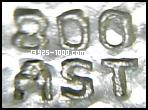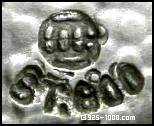Yogya Silver
Typical Yogya Silver Marks
• • •






• • •
|

|
The story of Indonesia's Jogya silversmiths is a recent one, it does not really begin until about the year of 1930.
In all of Southeast Asia, by the beginning of the twentieth century, the art of silversmithing was dying out. The local nobility had long been the primary source of commissions for silver work, but with their loss of power to colonizing nations came the loss of wealth to pay for luxury goods. This left the native silversmiths without a market for their goods, most had turned to other ways of earning a living and few were being trained in the craft.
In 1930, a Dutch woman, Mary Agnes van Gesseler Verschuir-Pownall, wife of the governor of Djokjakarta (Yogyakarta) in central Java in the Dutch East Indies, took an interest in reviving the local silver industry in the suburb of Kota Gede. Her plan was modelled on one that had succeeded a decade earlier in revivifying the silver trade in Cambodia, whereby local artisans were educated in their historical aesthetics, using historical architecture as the source, and encouraged to use this inspiration in the creation of silver objects modelled to fit European & Western needs.
Although Mary Agnes van Gesseler Verschuir-Pownall left Indonesia at the completion of her husband's term of office in 1933, she left behind a foundation, the Pakarjan Ngajojiokarta, composed of allied Dutch enthusiasts and Javanese aristocrats. The foundation successfully continued her work and the marriage of Javanese aesthetics to Western forms met with great approval and the silver craft thrived. The resulting silverware, often quite beautiful and well crafted, was mostly purchased by the local Dutch population and tourists to the area, primarily Americans.
After Indonesia won its independence from the Netherlands in 1949, the Yogya silver trade continued to thrive and flourished well into the 1960s. As almost all Yogya silver was purchased by foreigners, few vintage examples are left in Indonesia.
Yogya Silver Marks
It was not until the 1930s that the use of a maker's mark became common practice. The maker's mark and standard mark are also sometimes seen within a decorative cartouche and there are sometimes additional marks struck such as:
"Delux", "Deluxe", "Jogja Silver", "Pamor" (Indo-Malaysian for "luster"), "Echt" or "Nieuw" (Dutch for "real" or "new").
When a workshop changed hands, the new owner sometimes just added another initial to the pre-existing shop mark. It should be noted that the vast majority of Yogya marks are unidentified.
Addition Information
In 2005, the Tropenmuseum of Amsterdam mounted a major exhibition of Yogya silver and the catalog of the exhibition: Yogya Silver; Renewal of Javanese Handcraft by Pienke W. H. Kal is an important reference on the genre.
A recommended visit is Djokja.nl, a website devoted exclusively to Javanese silver with a great many illustrated examples of both Yogya silver and its makers' marks.
|
|

